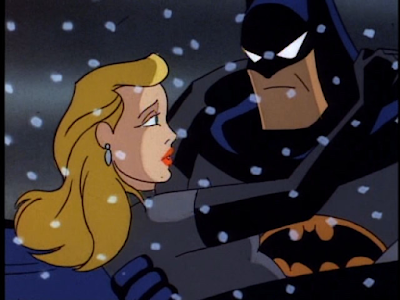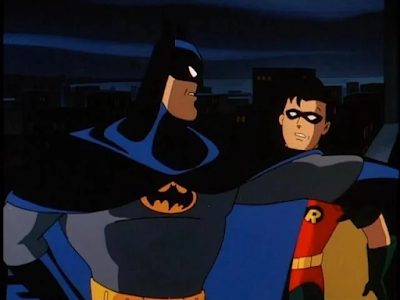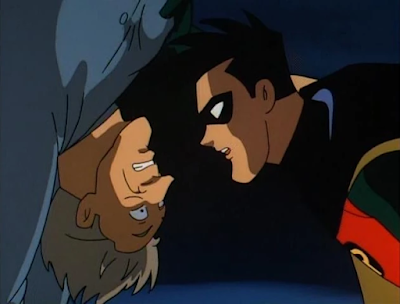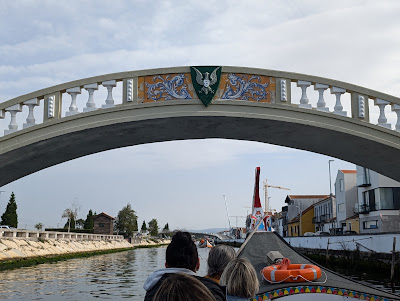At this point, it's worth questioning what ended up making the cut for two episodes on a story. The other two that we've seen were about the origins of Robin, Catwoman, and, of course, Two-Face; all of them massive figures in the mythos. (And how could you not do a two-parter about Two-Face?) But this one, about a relatively forgettable enemy in the form of the computer HARDAC, also got that treatment. Director Kevin Altieri mentioned that the original script for this story was even longer than a two-parter and they ended up cutting significant segments of it, both entire scenes and the detail in the included scenes, because of the budget and time that the animation studio had in order to do the work. That would come into play in a different sense, as well, when Altieri mentioned in the commentary that the original script had called for the final fight sequence to take place outside and he wanted a more "intimate" scene that would be more contained and what he felt suited the nature of the story (hi-tech, impersonation, etc.) The Batman's ability to escape the cliffhanger trap of part 1 (the claws that hold his glider) makes sense because, again, the device was just intended to hold a glider, not a 200+ pound man. The very presence of the claws was also just a nod back to the basic theme of the story in the first place (robots vs humans.) In that respect, it made sense for it not to be a relatively useless deathtrap like we see in the joke scene of Galaxy Quest or something equally unreasonable and that, too, is smart storytelling. Alfred also delivers the line of the episode: "I do wish your toys wouldn't play so roughly with you, sir!"
But this episode, just like the first one, still carries a lot of elements of famous science fiction productions. The staring, red eye of HARDAC is wholly reminiscent of that of HAL-9000 from 2001: A Space Odyssey, even if HARDAC's blinks when he speaks, unlike the ominous steady glow of HAL. He also mentions the "human frailties" that "threaten the plan", which is the whole focus of HAL's presence in that film. Likewise, Altieri and Bruce Timm mentioned that Karl Rossum was named after Guido van Rossum, the creator of PYTHON, so there are all kinds of little references throughout. Another one is Randa Duane resembling Marilyn Monroe, as they tried to stay in theme with the times as technology of the more mundane story (cars, etc.) are presented as a 1930s-era depiction throughout the series, so even the hi-tech stuff tends to stay that way, too (HARDAC taking up much of a warehouse, as the original ENIAC did, as well.) Interestingly, Altieri mentions that the spider-like activity of the "duplicants" when they begin battling The Batman was inspired by a character from Legend of the Overfiend, which is a fairly niche (and pornographic) corner of the animation world. That follows in form with another apparent SF reference, which is the glowing, red eyes of the robots; not with a lens sheen like HARDAC's, but more diode-appearing as was the case with the antagonist of The Terminator.
But one of the best moments of the episode is something that Altieri and Timm said they tried to avoid: the appearance of the Batsignal. All we see is the symbol on the clouds, no sound, no music. Just the light. It felt iconic to me but they had said they wanted to avoid it, perhaps because they thought it made him too familiar and less of the mysterious Dark Knight that they wanted to portray. (The menace from the shadows doesn't respond to a searchlight-!) The continuation of the scene is the appearance of Harvey Bullock's "duplicant" who then begins to literally toss The Batman around the rooftop. But it still looks and sounds like Bullock, so when Barbara Gordon assists our hero in tossing Bullock into the Batsignal, where he's electrocuted and "dies", it's a moment of surprise for the viewer, because the characters have to know that what they're doing is likely lethal if this somehow is Bullock. Barbara even tears up before the skin covering falls away and the robot falls apart. It's quite a (ahem) shocking moment that they somehow got past Standards & Practices (Altieri said that once the review board knew they were robots, they could be as violent as they wanted. And they were.) There's also a great moment at the end where our hero delivers the line: "Please let go of my cape." as Barbara attempts to extract a promise from him about finding her father. This, of course, only makes me think of The Watchmen and, of course, The Incredibles.
Speaking of Barbara, she has an interesting role in this one, since all of us older fans know that she's Batgirl from the comics, but in this instance they take the time to show her own initiative and intelligence and round her out as her own person, minus the costume (and the cape!) There's also an interesting choice of perspective switch when she's being followed by the robot trashcan in Rossum/HARDAC's lair and is captured by "duplicants." At that moment, instead of switching to the narrator's overhead view of events, we instead see them from the perspective of the robot, which has switched back to its trashcan role. In most other episodes, we would've stuck with the "reader of the comic page" view, rather than dropping to that of a nameless extra character. In the end, the massive fight scene ends in one of the more explosive conclusions, with everything being destroyed and/or burning to the ground (S&P said we could-!) and Rossum suggesting that it was all the AIs fault and the mayor, having been kidnapped and held in a hibernation tank, happily agreeing with him because he apparently did it "for the children" (his deceased daughter.) That's the departure from much of standard SF, where the inventor is held responsible for his creations.




















































